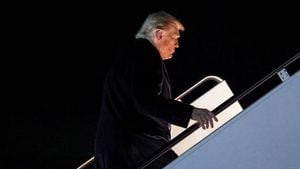Americans are waking up to a new reality: their morning cup of coffee is costing them more than ever before. According to U.S. government figures, the average price of a pound of ground coffee soared to $9.14 in September 2025—a 3% jump from August’s $8.87 and a staggering 41% leap compared to September 2024. That’s not just a blip on the radar; it’s part of a sharp, sustained increase in coffee prices that’s been brewing since the start of the year, as reported by the Associated Press.
This spike isn’t just limited to coffee beans on grocery store shelves. The U.S. Labor Department reported that consumer prices for food—whether purchased for home use or enjoyed at a café—were up 3% in September 2025 compared to the same month last year. The consumer price index, which tracks a broader basket of coffee products (including instant coffee), showed prices up 19% from September 2024. For many Americans, that means their daily caffeine fix is hitting their wallets harder than ever before.
At the ground level, small business owners are feeling the squeeze. Nikki Bravo, co-owner of Momentum Coffee in Chicago, recently raised prices by about 15% at her four locations. The decision wasn’t made lightly. "At some point we just had to pass it along, we couldn’t continue to eat it," Bravo explained to the AP. She’s paying 15% more for coffee beans than she did a year ago and has started roasting more beans in-house to cut costs. Most of her beans come from Africa, but it’s not just the beans that are pricier—cups, sleeves, and other essentials have all gone up. Add to that a minimum wage hike in Chicago to $16.60 an hour as of July 1, 2025, and the pressure builds. Stubbornly high inflation has left consumers uncertain and less willing to splash out on a takeout coffee, Bravo noted.
The ripple effects are clear in the numbers. Restaurant management system Toast reported that the average price of a regular coffee at U.S. restaurants in September was $3.54, up from $3.45 a year earlier. But why is java feeling such a jolt? The answer, it turns out, is a complex blend of tariffs, weather, and global supply chain woes.
First, consider tariffs. The U.S. is not a significant coffee producer—outside of Hawaii and Puerto Rico, there are few places where coffee can be grown. That means 99% of America’s coffee is imported, according to the National Coffee Association. Brazil, which supplies 30% of the U.S. coffee market, has been hit particularly hard. The Trump administration imposed a 40% tariff on Brazilian coffee products in July 2025, adding to an earlier 10% tariff. As a result, Brazilian producers have begun withholding shipments to the U.S., negotiating with American roasters over who will absorb the added cost. The upshot? A reduced supply of coffee beans stateside, according to investment bank UBS.
The situation isn’t much better with other major suppliers. Colombia, which provides 20% of the U.S. coffee market, is subject to a 10% tariff. President Donald Trump recently threatened even higher tariffs and an end to U.S. aid to Colombia. Vietnam, another key player supplying 8% of the U.S. market, has faced a 20% tariff since the summer of 2025. In September, Trump announced that "unavailable natural resources" could be exempt from tariffs for countries that have reached trade agreements with the U.S., but coffee hasn’t yet received any such exemptions.
Weather, too, has brewed trouble for coffee lovers. Heat, drought, and other poor weather conditions have battered coffee production worldwide in recent years, pushing prices ever higher. The Food and Agriculture Organization of the United Nations reported that world coffee prices rose nearly 40% in 2024. Earlier this month, prices ticked up again after the National Oceanic and Atmospheric Administration declared that La Niña conditions had formed, raising fears of drought in Brazil. The threat from climate change has some researchers working to develop more climate-resistant coffee varieties, but for now, the risks remain stubbornly high.
With so many factors pushing prices up, some in Congress are looking for ways to offer relief to American consumers. In September, a bipartisan group of U.S. House members introduced a bill to repeal all tariffs on coffee. Representative Ro Khanna, a California Democrat, put it bluntly: "We only produce 1% of the coffee that Americans consume. It’s one of the best examples of Trump’s blanket tariffs making no economic sense." Khanna co-sponsored the bill with Representative Don Bacon, a Nebraska Republican, who was motivated after seeing grocery store coffee prices skyrocket. Bacon, who isn’t a fan of tariffs and believes Congress—not the president—should levy them, said, "I hope the president and Congress see the positive benefit of removing this tariff on everyday Americans."
The proposed legislation highlights a rare moment of bipartisan agreement, rooted in the practical reality that the U.S. simply doesn’t grow enough coffee to meet domestic demand. Supporters argue that removing tariffs would lower costs for consumers and help small businesses like Bravo’s. Critics of the current tariff policy say that while tariffs are often intended to protect American industries, in this case, they only serve to drive up prices for a product that’s almost entirely imported.
Meanwhile, coffee shop owners like Bravo are doing what they can to adapt. Roasting more beans in-house, sourcing from different regions, and making tough decisions about menu pricing—all in an effort to keep their businesses afloat and their customers coming back. But with inflation showing few signs of abating and global supply chains still under strain, it’s unclear how soon relief might come.
For now, Americans who rely on their daily cup of joe are left with little choice but to swallow higher prices. Whether Congress can offer a fix—and whether it will be enough to counteract the forces of climate and global trade—remains to be seen. One thing’s for sure: coffee, once a humble staple of the American morning, has become a symbol of the broader economic pressures facing consumers and small businesses alike.
As the debate over tariffs and supply chains continues in Washington, and as weather patterns threaten the world’s coffee harvests, the simple act of sipping a cup of coffee has become a little more complicated—and a lot more expensive.






